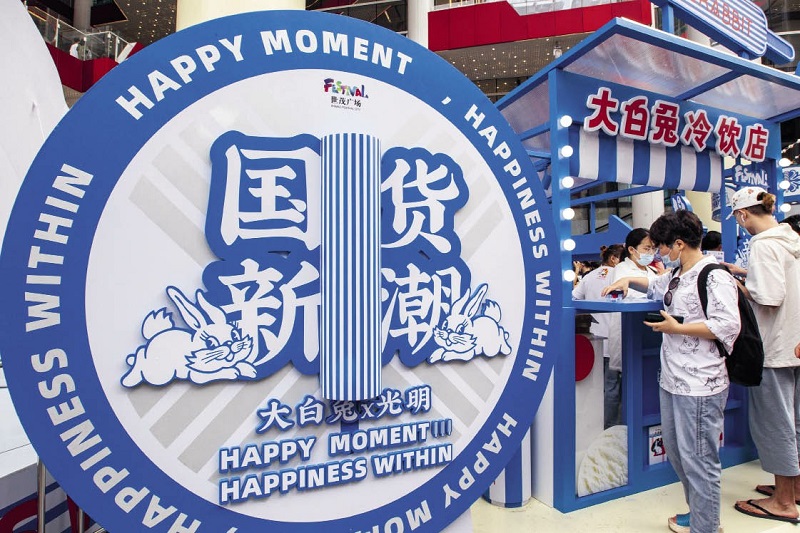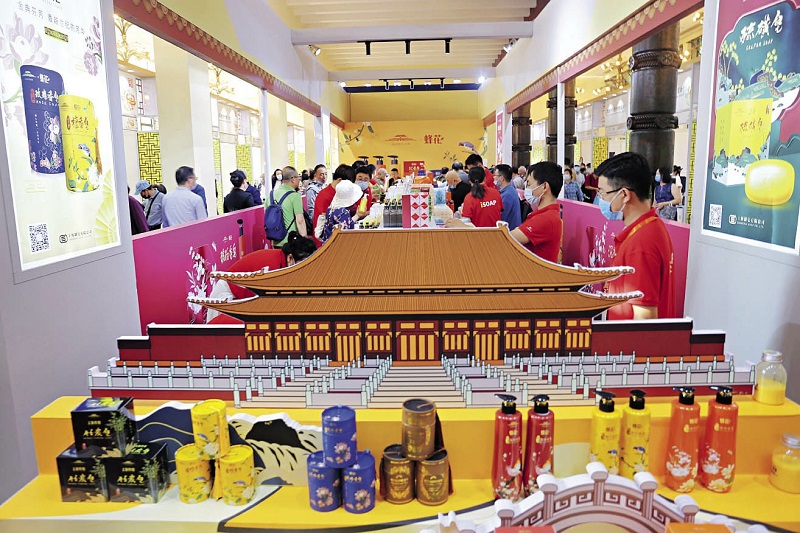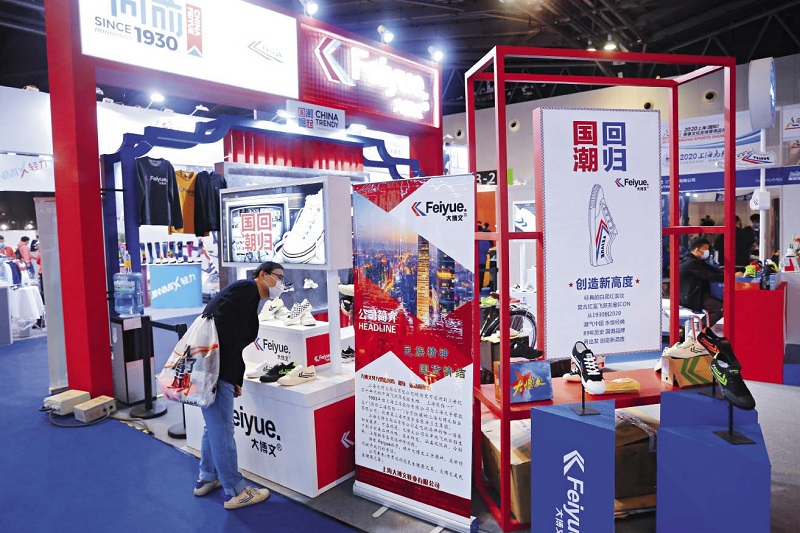IN recent years, domestic products have been the rage in the consumer market with renewed time-honored brands, upgraded traditional brands, and emerging new brands. Purchasing and using China-made goods has become a daily routine for many people, especially the younger generation.
Facing intensified market competition and escalating consumer demands, many Chinese brands are not only maintaining their cost-effective advantage, but also changing their original appearance in cross-border integration and showcasing new features. In response, many consumers have expressed pleasant surprise that domestic products can be so trendy.

New products of the White Rabbit Creamy Candy attract citizens in Shanghai on June 6, 2020.
A New Look after Transformation
Confronted with increasingly diversified consumer demands, how can clothes be designed in a unique way? When modern clothing meets traditional culture, the effect produced is beyond one’s imagination.
Lately, the domestic clothing brand Peacebird joined hands with the film Mulan to combine traditional Chinese clothing with the popular concept of intellectual property (IP) and created a co-branded fashion series called “Mulan’s New Clothes,” which became a hit soon after the release. Prior to this, Peacebird had cooperated with multiple well-known brands or IPs such as the potato chip brand Lay’s and Sesame Street and releases a number of co-branded products, arousing much discussion on social media.
However, not long before, the general impression people had for Peacebird was the business formal style. “I once felt that this brand’s products were not suitable for young people,” said Li who was born after 1995, who recently found that the brand had launched many trendy styles and bought a cool and faddish T-shirt co-branded with Coca-Cola.
Peacebird’s try to appeal to young people has become a vivid example of the rise of domestic fashion brands. In recent years, many domestic brands have taken the initiative to transform old and create new products through the introduction of new ideas, technologies, and models, launching a new wave of domestic brands’ resurgence.
To name some, Shanghai M&G Stationery added the element of Peking Opera to a seemingly small product of a few dollars, turning it into a big business with an annual revenue of over RMB 8 billion. China’s renowned chili sauce Lao Gan Ma launched a hoodie with its logo. These products, by incorporating cultural connotations and taking advantage of the opportunities of the times, can always attract consumers.
In addition to the changes of traditional brands, a large number of new domestic brands have also sprung up. A short-sleeved T-shirt launched by GENANX last spring has sold nearly 100,000 pieces on the online shopping app Dewu. The brand GENKI FOREST has become an influencer in the production of sugar-free and low-calorie beverages within the last four years. The makeup brand Perfect Diary has more than 25 million fans online and more than 1 billion monthly views.
In addition to this, many cool tech products have also become popular among youngsters. The TaiChi midsole material developed by Peak Sport Group has been applied to basketball shoes, slippers, and other products. With the unique comfort and functionality, it has quickly become faddish and is in short supply in the market. The results also helped Peak Sport, which was in a slump, make a beautiful turnaround.
According to the 2020 development report on China’s consumer brands released by the Ali Research, 80 percent of sales on Tmall are about domestic products. Among the brands with sales of over RMB 100 million during the double eleven online shopping carnival in 2019, there were 173 domestic brands, accounting for nearly 60 percent.
According to CBNData, the search index related to new domestic products showed a steady rising trend, and the online domestic product market consumption scale has maintained growth in the past three years.
It is thus evident that today’s domestic brands are no longer just synonymous with cheap prices, but are also a trend-setter of quality and fashion.

Visitors are attracted by well-packaged products at China’s Time-Honored Brands Expo 2020 in Shanghai on October 10, 2020. Many classic domestic products are displayed with innovative changes, and traditional skills are integrated with new technology and popular culture.
Complying with New Consumption Concept
“The White Rabbit Creamy Candy is one of my childhood memories!” said the post-90s Xiao. She works in Beijing and is familiar with its crossover products during the past few years, from co-branded ice cream to pop-up shop’s milky tea, to newly-released hand cream and body shampoo. In short, Xiao will buy any product related to this brand soon after its release.
“These products combine time-honored elements with daily necessity, which are both practical and cultural,” said Xiao. “More importantly, behind the candy are my childhood memories, and I am willing to pay for it.”
Wu, who is also a post-90s, pays more attention to domestic trendy brands. “Li-Ning is one of my favorite domestic fashion brands,” he said. “The brand promotes to the world Chinese characteristics with its Chinese name, making people feel national pride and deepen the love for this brand.”
According to Wu, wearing trendy brands and talking about fashion has nothing to do with getting recognition of others, nor is it a kind of conspicuous consumption. It is just an expression of heartfelt love and feels that it is fashionable and beautiful to wear.
According to the 2020 consumption data report on young people regarding trending consumption released by Dewu app and fashion.sina.com.cn, the “passion-price ratio” has become a keyword of trendy consumption. Young people’s consumption shows trends such as purchasing for passion, domestic trendy brands, and communication with peers.
According to the analysis of Dewu app, young consumers, represented by the post-90s generation, no longer care about whether the product is a foreign or domestic brand. They consume more to satisfy their own aesthetic preferences and pay an increasing amount of attention on the emotional story and spiritual value behind the product. This is a consumption concept of “please oneself.”
In order to draw the attention of more young people, many domestic brands not only cater to the aesthetics and needs of young consumers in product design, but also actively participate in new commercial activities such as new retail and live commerce in marketing, and continue to do well in the online community operation and content dissemination.
On the Dewu app platform, users can not only purchase various trendy brand products, but also exchange their consumption experience and share daily trends, which makes the platform possess the dual attributes of social contact and e-commerce.
According to Wu Guoqiang, chief operating officer of the domestic fashion brand GENANX, young people tend to share their favorite things online, which can allow more users to increase their understanding of the product, forming new consumption ecology from “understanding” to “acquisition,” and then to “communication.”
“Young people are now progressively accepting fashion brands, thanks to the development of this Internet community with both e-commerce and social attributes,” said Wu.
In addition, experiential consumption, short video broadcasting, and other methods are also helping introduce domestic products to young people. On June 7, 2020, China Central Television’s website cctv.com and GOME Electrical Appliances jointly launched a live streaming program named “Everyone Loves Made-in-China,” attracting nearly 10 million viewers, with total sales of RMB 720 million.
Zhao Yupei, a PhD supervisor in the College of Media and International Culture in Zhejiang University, pointed out that the biggest driving force for the rise of national trendy brands is young people. “The younger generation not only represents a change in the traditional trend, but also a change in the direction of consumption and capital. After market testing, domestic fashion brands will undoubtedly be vigorously promoted by capital, policies, and media.”

Chinese sneaker brand Feiyue showcases its innovative technology for making running shoes at an expo focusing on sporting goods in Shanghai in November 2020.
Expanding New Space with Culture
In recent years, Lang Zi, chief designer of Li, a brand of traditional Han Chinese clothing, has clearly felt that young people nowadays are willing to understand and learn about traditional Chinese culture. For that, traditional Han Chinese garments have gradually gained traction in the consumer market.
Last year, Lang transitioned to designing traditional Han Chinese clothing and founded the brand Li. “Adhering to the concept of preserving the ancient charm and incorporating new elements, we strive to combine traditional and modern designs,” said the designer. “We hope that Han Chinese attire can be matched with some modern items, such as T-shirts and jeans, making the traditional clothes more popular and fashionable,” she added
Behind the popularity of traditional Han Chinese attire is the fashionable expression of cultural elements in commodities. Now, a growing number of local designers choose to incorporate Chinese traditional cultural symbols into the design of commodities. For instance, some products use blue and white porcelain, Great Wall, splash-ink, tie-dye and other creative ideas that contain Chinese elements and traditional craftmanship elements. Some brands choose to co-brand with traditional cultural IPs such as the Forbidden City.
According to Yang Bing, founder of Dewu app, the rise of domestic fashion brands is a manifestation of cultural confidence among young people. Witnessing the continuous development of the country, they have seen that traditional Chinese culture is increasingly recognized internationally. In their eyes, traditional cultural symbols are gradually equated with individuality and characteristics, so they are willing to purchase domestic products to show their individuality and national pride. The rise of domestic brands, in turn, strengthens consumers’ inner cultural confidence and shapes the aesthetic pursuit of young people.
According to experts, behind the boom of domestic brands is not only the rise of Chinese manufacturing and Chinese brands, but also a manifestation of Chinese feelings and cultural confidence. The upgrading of manufacturing in China is the basis for the formation of this boom. The continuous improvement of the consumption capacity is another important reason for the trend. The joint action of the government, the media, and enterprises is a powerful boost to the formation of the national boom.
As domestic brands continue to tap traditional cultural values and manufacture higher-quality products, not only will popularity of domestic products among local consumers gradually increase, but it will also accelerate the pace of going global. Innovating cultural dissemination and telling China’s story will gain a stronger momentum for the development of domestic fashion brands in the future.
JIANG ZHONGQI and QIAO CAI are reporters with People’s Daily overseas edition.